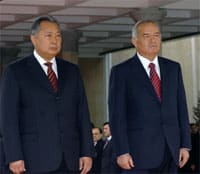Russia has often been accused recently of “energy blackmail,” using its large hydrocarbon reserves to gain political influence in countries which are dependent on energy imports from Russia to sustain their economies. Both Ukraine and Belarus made major headlines when Russia demanded sharply higher prices for delivering natural gas to them – under the threat of turning off gas supplies in the middle of winter. These headlines were largely generated due to the fact that Europe is also dependent on the same pipelines that feed into these countries; a gas cut for one country could mean gas shortages in another. Europe’s anxieties over pricing disputes that might jeopardize its own supply of energy are now often credited with keeping Gazprom’s appetite for “market prices” at bay.
A similar situation is occurring in Central Asia, with Kyrgyzstan subjected to similar “bullying” by other regional powers with developed energy resources – in particular Uzbekistan. Furthermore, Kyrgyzstan lacks a “big brother” to play the protecting role Western Europe is currently playing for East European states. Kyrgyzstan, although making few headlines regarding its precarious energy situation, is currently attempting to steer a course between Scylla and Charybdis, the great monsters from Greek mythology who sat on opposite sides of a narrow channel and grabbed at passing sailors. Moving away from the Charybdis of doing nothing and falling further in debt to power-hungry Uzbekistan, Bishkek is developing domestic energy alternatives with foreign financing from Moscow and using its own natural resources as political tools. However, as in the myth, this potentially brings Kyrgyzstan closer to the multi-headed Scylla of regional conflict, persistent foreign control over its domestic energy sector, and committing violations of international law.
Untapped Wealth

Kyrgyz President Kurmanbek Salievich Bakiev meets US Secretary of State Condoleezza Rice
Despite some expectations that Kyrgyzstan may possess large underground deposits of gas and oil – those assets remain simply hopes and dreams, as the debt-ridden country lacks the economic and technological capability to explore and exploit new deposits on its own and foreign investors have yet to come forth to cooperate with local energy firms. This reluctance, in part, stems from the fact that there are many larger, more accessible sites elsewhere in Central Asia. Moreover, local Kyrgyz “partners” are ill-equipped to provide the local support that outside investors seek for such complicated, expensive projects. These partners, which the Kyrgyz government demands foreign firms use, have unfortunately shown that their major expertise lies in siphoning profits.
According to Vladimir Kiselev, professor of geology and mineral science at Kyrgyzstan’s National Academy of Science, the country has the potential to produce and exceed 66 percent of the current total oil and gas production of the Ferghana valley. Still, Bishkek continues to import all of its gas from neighboring Uzbekistan at a rate of about 25 billion cubic feet annually, Uzbekistan is not a gas producing juggernaut like Russia, but with 66.2 trillion cubic feet (tcf) in estimated reserves, it ranks near the top 10 natural gas producers in the world and is thus a major regional power. Significant fields within Uzbekistan such as Uchkyr and Yangikazgan, depleted during Soviet rule in the 1960s and 1970s, have decreasing outputs, but the country is securing investment and moving to begin production in new, promising fields.
Uzbekistan plays a vital role meeting Kyrgyzstan’s heating and energy demands; Tashkent is perhaps as important an energy supplier to Central Asia as Moscow is for most of Europe. The only major pipeline connecting Kyrgyzstan to the larger network is the Tashkent-Bishkek-Almaty pipeline. Other pipelines in the region avoid Kyrgyzstan or push resources north and west, a legacy of the Soviet Union’s central economic planning that redirected energy to the Russian center of Moscow. Future regional pipelines, such as the proposed Turkmenistan-Afghanistan-Pakistan-India line, are not projected to link with Kyrgyz territory.
Charybdis: The Danger of Doing Nothing

Uzbek President Islam Karimov with Rice, Rumsfeld, and Powell.
The ongoing Bishkek-Tashkent dispute over natural gas deliveries and payment for them is not new. For example, in 2000, while Kyrgyz security forces fought a series of battles with Muslim rebels, including members of the Islamic Movement of Uzbekistan, Uzbekistan’s President Islam Karimov cut gas supplies to Kyrgyzstan, with the official reason given that Kyrgyzstan was slow in making payments. The already weakened country suffered energy shortages throughout its northern regions, as well as the capital, Bishkek. In addition to obviously negatively affecting daily business, life, and moral, this created further strain on Kyrgyzstan’s aging energy infrastructure; blackouts and power outages can damage generators, electrical grids, and related equipment.
In December 2001, Kazakh officials with the state gas company Kaztransgaz reported the loss of 10 million cubic meters (mcm) of natural gas from the Tashkent-Bishkek-Almaty pipeline. Officials with the state-run Kyrgyzgaz eventually admitted to siphoning some 15 mcm in November and early December of 2001, shortly after another gas cutoff by Tashkent. At the time, Kaztransgaz Director Kairat Sharipbaev warned that continued theft of gas could force Kazakhstan to build a new 81 mile bypass around Kyrgyzstan. This move by Kazakhstan could further weaken Kyrgyzstan’s position in Central Asia and its energy security.
In 2005, Tashkent put the squeeze on Bishkek again after the Kyrgyz government transferred refugees from the Andijan massacre, in which Uzbek security forces slaughtered hundreds of protesters, to other countries which had offered them asylum. The Uzbek government in general took the event, which turned into an international debacle, politically very seriously. After Washington voiced mild disapproval of the Uzbek response in Andijan, Uzbekistan evicted US forces from the military base of Karshi-Khanabad, also known as “K2.” Bishkek was punished with gas cuts. Tashkent quickly annulled an agreement providing for the supply of some 350 mcm of natural gas to Kyrgyzstan. To forestall critical shortages, the Kyrgyz government was forced to buy Uzbek gas resold by Kazakhstan’s KazTransGaz company at heightened prices. The Kyrgyz-Kazakh agreement also demanded reassurances that a Kyrgyz debt of US$17.5 million would be repaid for continuing gas deliveries.
In a move taken straight from the Gazprom play book, in the summer of 2006, Uzbek authorities warned neighboring Tajikistan and Kyrgyzstan that they would have to renegotiate prices paid for deliveries of natural gas. By the middle of December, Kyrgyz First Deputy Prime Minister Daniyar Usenov announced the conclusion of a deal that would see Bishkek’s price for gas nearly double: from $55 per 1,000 cubic meters to $100 starting in January 2007. This avoided the last-minute showdown witnessed in Belarus in its conflict with Russia. However, the deal has negatively impacted government and individual finances in Kyrgyzstan, despite the fact that Kyrgyzstan managed to achieve a reciprocal increase in the price for electricity deliveries to Uzbekistan – power that is generated by mountainous Kyrgyzstan’s water resources and hydroelectric plants. The Kyrgyz deputy prime minister announced that prices would increase to .02 USD per kilowatt hour by the end of 2007 (up from .01 USD in 2006).
The higher gas prices could still spell disaster for Kyrgyzstan. Households are largely dependent on gas for cooking and heat and household gas prices in 2007 have been forecasted to rise more than 44 percent for the year. This comes at time when escalating inflation is already creating a situation that some analysts are predicting could turn into yet another economic crisis for Kyrgyzstan. Indeed, the situation could get worse as the strength of the neighboring Kazakh economy this year and next is predicted to soak up area resources, driving up the cost of living dramatically for hundreds of thousands of Kyrgyz.

Kyrgyz President Kurmanbek Salievich Bakiev and Uzbek President Islam Karimov at a meeting in October of 2006.
Furthermore, the rise in electricity export prices is only a partial victory; In addition to exporting electricity to Uzbekistan from Kyrgyzstan’s southern regions, electricity is imported from Uzbekistan to supply its northern regions. This is due to the now outdated Soviet-built electrical grid, built to avoid the rough Tien Shan Mountains that run through central Kyrgyzstan. Plans to build a 249 mile 500kV transmission line, as well as a new 220kV decongestion line connecting northern and southern regions, are in the works to alleviate this problem. As Uzbekistan also controls part of the energy delivery systems in Kyrgyzstan (another play from Gazprom’s book), the National Electric Grid of Kyrgyzstan is looking at building and replacing several 220kV transmission lines in the south, thanks in large part to recent international loans. However, in both cases Bishkek will have to wait until at least 2009 (and likely longer) for these difficult projects to come to fruition.
Scylla: The Danger of Doing More
In strengthening its regional position, water and hydroelectricity could be Bishkek’s best tools, enabling (potentially) valuable electricity exports to reach neighbors in South Asia and providing for its own domestic energy consumption. In addition, Bishkek’s control of riverflows that reportedly account for some 70 percent of Uzbekistan’s water supply would be an obvious bargaining chip in the event of a crisis. The loss of this supply would severely damage Uzbekistan’s monoculture production of cotton, which plays a large role in its national economy. However, international law prohibits this chip from being played. Kyrgyzstan cannot threaten to deprive Uzbekistan of water resources – as understood in agreements signed with the United Nations, or even overuse the rivers – as understood by customary international law, even if faced with severe gas shortages.
Indeed, during the recent Shanghai Cooperation Organization’s (SCO) August 2007 summit in Bishkek, Uzbekistan’s President Karimov took the opportunity to remind his hosts that hydroelectric development required consultation with affected parties. He further suggested that compensation should be paid to those parties if river flows are altered.

The rugged terrain of Kyrgyzstan and Tajikistan creates both transportation problems and hydroelectric possibilities
These comments are especially pertinent today as a major Russian-Kyrgyz hydroelectric project is just getting underway. On December 15, 2006, Kyrgyzstan and Russia announced an agreement to launch a billion-dollar project, which could see Kambarata-1 and Kambarata-2 hydroelectric cascades built to supply electricity for domestic consumption and for export to Afghanistan, China, or Pakistan. “This will be a top investment project worth billions of dollars, and will be of the utmost significance from the point of view of Kyrgyzstan’s influence in the region,” said Sergei Kiriyenko, head of Russia’s Federal Nuclear Power Agency.
However, the project will affect flows to larger nearby countries – particularly Uzbekistan and Turkmenistan. Such development could lower the water levels of the Syr Darya or Amu Darya rivers, ultimately harming neighbors’ cotton crops that depend on the significant riverflow from these sources for irrigation.
Due in part to these diplomatic difficulties, Kyrgyzstan is only exploiting about 10 percent of the country’s hydroelectric potential, estimated at 163,000 gigawatt hours/year. Stream usage is even lower, at about 3 percent of potential. Other strategies for improving Kyrgyzstan’s energy independence have proven economically infeasible. Kyrgyzstan transitioned away from geothermal energy production in the 1990s because of transportation issues. Solar power remains expensive, and is still in the early stages of development. Finally, wind power still poses some difficulties with a limited (1,500 megawatt projected) capacity, rough mountain environment for operation and a relatively high cost – according to a European Bank for Reconstruction and Development report.
Implications for International Relations
From a US foreign policy perspective, a weakened Kyrgyzstan is a worrisome development. Kyrgyzstan is a moderate, democratic Muslim nation, and has been one of the America’s most reliable allies in the volatile and energy-rich Central Asian region. Manas Air Base, located near Bishkek, has been instrumental in Washington’s Global War on Terror and operations in Afghanistan.
However, relations have soured significantly since Washington launched the Global War on Terror. Plunging prestige and worsening relations with Muslim states have meant that is harder for Bishkek to justify a cozy friendship with the United States to the Kyrgyz people, and such connections to Washington have become a liability in Kyrgyzstan’s more immediate diplomatic concerns with the other Muslim states that surround it.
The United States is also not giving Kyrgyzstan much reason to maintain close relations. Because of its political and geographic isolation in Central Asia, Bishkek originally welcomed the arrival of the US base at Manas Airport, likely expecting follow-on opportunities for cooperation and development. Yet, several years after the establishment of the base, opportunities for deeper cooperation have been few. US soldiers are now actually prohibited from visiting the capital and spending money, and UN and European development officials – rather than US diplomats – are seen as primary implementers for aid and development projects in the country.
Furthermore, Russia, now universally acknowledged as a competitor to the United States for influence in Central Asia, has greatly and actively stepped up efforts to provide aid and investment, not only bringing cash to develop valuable hydroelectric projects, but also providing sizable military and economic aid packages, outstripping the minor efforts of US military-run training programs. Given Washington’s lackluster diplomacy, it is understandable that over the past two years, Kyrgyz politicians have shifted closer to the Russian orbit. This shift could become even more pronounced should Russia, once the new Kyrgyz domestic energy production facilities come online, use its ownership stakes in those facilities to push Moscow’s own political agenda in Kyrgyzstan. The energy sector is an area for cooperation that could benefit not just international relations and the Kyrgyz state, but thousands of citizens in rural population centers. Bishkek, therefore, seems set on a course for greater energy cooperation with Russia at the expense of Uzbekistan. The US, in this case, has been marginalized as its State and Energy Dept. spending have not been directed with renewable energy goals in mind. Washington thus stands to lose out in valuable Central Asia, as has shown little desire to help chart its close ally through the turbulent strait that is Central Asian geopolitics.


